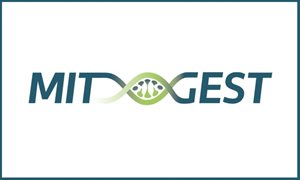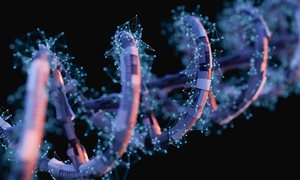1 October 2019
Mutations in genes encoding components of the mitochondrial DNA (mtDNA) replication machinery cause mtDNA depletion syndromes (MDS), which associate ocular features with severe neurological syndromes. Here, we identified heterozygous missense mutations in SSBP1 in five unrelated families, leading to the R38Q and R107Q amino-acid changes in the mitochondrial single-stranded DNA-binding protein, a crucial protein involved in mtDNA replication. All affected individuals presented optic atrophy, associated with foveopathy in half of the cases. To uncover the structural features underlying SSBP1 mutations, we determined a new revised SSBP1 crystal structure. Structural analysis suggests that both mutations affect dimer interactions and presumably distort the DNA binding region.Using patient fibroblasts, we validated that the R38Q variant destabilizes SSBP1 dimer/tetramer formation, affects mtDNA replication and induces mtDNA depletion. Our study, showing that mutations in SSBP1 cause a novel form of dominant optic atrophy frequently accompanied with foveopathy, brings new insights into mtDNA maintenance disorders.

Mutations in genes encoding components of the mitochondrial DNA (mtDNA) replication machinery cause mtDNA depletion syndromes (MDS), which associate ocular features with severe neurological syndromes. Here, we identified heterozygous missense mutations in SSBP1 in five unrelated families, leading to the R38Q and R107Q amino-acid changes in the mitochondrial single-stranded DNA-binding protein, a crucial protein involved in mtDNA replication. All affected individuals presented optic atrophy, associated with foveopathy in half of the cases. To uncover the structural features underlying SSBP1 mutations, we determined a new revised SSBP1 crystal structure. Structural analysis suggests that both mutations affect dimer interactions and presumably distort the DNA binding region.Using patient fibroblasts, we validated that the R38Q variant destabilizes SSBP1 dimer/tetramer formation, affects mtDNA replication and induces mtDNA depletion. Our study, showing that mutations in SSBP1 cause a novel form of dominant optic atrophy frequently accompanied with foveopathy, brings new insights into mtDNA maintenance disorders.
-
Want to know more about these subjects? Click on the buttons below for more news.
Related news items

Hans Spelbrink is beneficiary of the MITGEST Doctoral Network which receives 2.6 million euros funding (PhD positions available)
27 September 2022EU has granted the new Doctoral Network “MITGEST” (Quality Control of the Mitochondrial Gene Expression System in Health and Disease), of which Radboudumc is one of the partners, with 2.6 million euros of funding under the Marie Sklodowska-Curie Actions.
read more
Towards a better understanding of Leigh Syndrome pathology and intervention published in Brain
8 December 2021 Melissa van de Wal and colleagues recently published a comprehensive review in the journal Brain on how Ndufs4 knockout mouse models have been used to unravel the pathomechanism of Leigh Syndrome. read more
New genetic defect links cell biology and protein glycosylation
10 November 2021 Peter Linders, Dirk Lefeber and Geert van den Bogaart together with international colleagues have recently reported on novel cell biological insights, by identifying a genetic disorder in syntaxin-5 which allowed to unravel a new mechanism regulating intracellular transportation. read more
RIMLS awards call for nominations
19 October 2021 RIMLS awards several prizes to stimulate and honor our (young) researchers. Upcoming awards are Supervisor of the Year, Best Master Thesis, Best Publication, Best Image and more. Send your nominations now before 24 November 2021. read more
Khondrion begins study on optimal dosage of new drug
10 February 2020 Pharmaceutical company Khondrion, a spin-off from Radboudumc, has taken another important step in the development of its drug sonlicromanol. The first patients have used the drug as part of a phase 2b study, which focuses on determining the optimum dose and efficacy. read more
